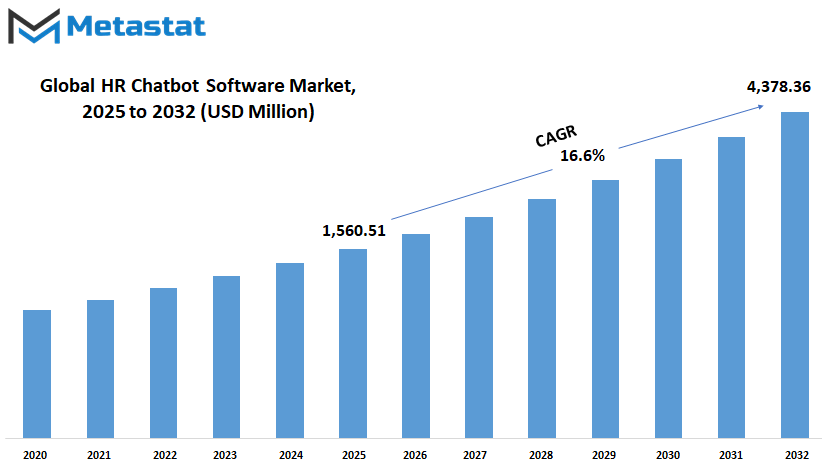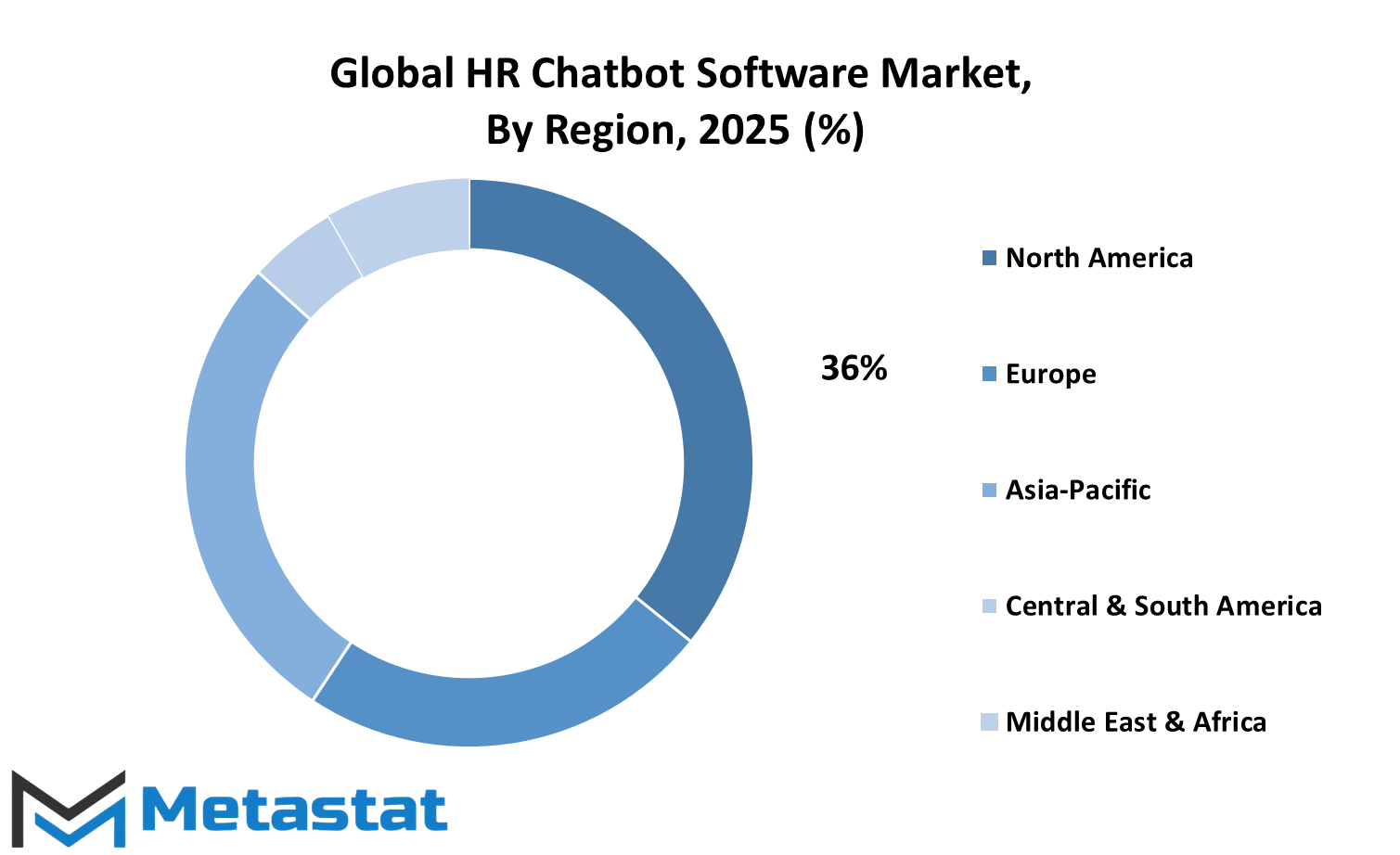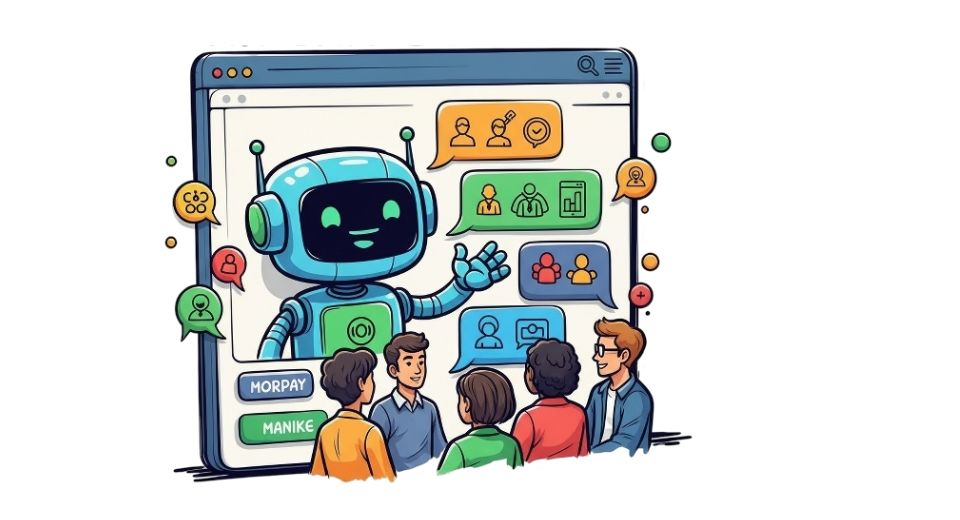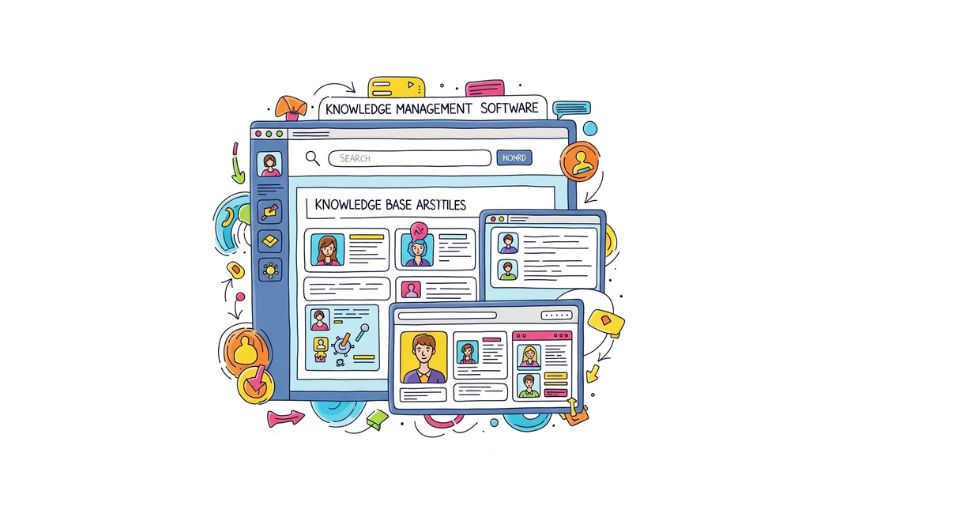MARKET OVERVIEW
The global hr chatbot software market lies within the larger enterprise technology and human resource management sector, where software systems continue to facilitate internal efficiency and employee engagement. This particular segment will establish the framework through which organizations control real-time employee interactions by facilitating conversations with digital agents targeted for the human resources department. With natural language processing and conversational interfaces, HR chatbot software will revolutionize the way admin work is managed at scale, particularly in corporations dealing with workforce complexities in regions. The global hr chatbot software market will be a solution space where digital automation will blend with strategic talent operations.
It will serve as a means to facilitate HR departments in performing crucial tasks like onboarding, benefits explanation, policy advice, leave administration, and performance check-ins using automated, AI-based interactions. With increased demands on HR departments and an increasingly digitally savvy workforce, this market will provide structured platforms to reduce human workload in domains that include high volumes of repetitive questions and procedural responses. Geographically, the global hr chatbot software market will be defined by various regulatory and language settings. Software vendors would need to tailor their products to localization specifications while being compliant with local labor standards and data protection policies.
The market will not stop at multinational corporations; mid-sized companies and startups will begin incorporating chatbot platforms as they make the shift to cloud-first HR software. Cloud-native deployment will drive market action, with the ability to configure remotely and use on a scalable basis, particularly as hybrid work arrangements continue to reshape organizational frameworks. The reach of this market will extend beyond English-speaking corporate environments. Multilingual functionality and cultural sensitivity in chatbot development will become essential features, allowing the software to communicate with users of various backgrounds with precision and customization. The growth of intelligent integrations will also be witnessed, with HR chatbot software operating together with enterprise resource planning systems, learning management platforms, and employee well-being tools.
This integration will chart the future course of how these solutions are taken up across industries such as healthcare, finance, logistics, and education. From a deployment model perspective, Global HR Chatbot Software vendors will focus on subscription-based offerings, with flexible packages that fit various organization sizes and in-house technical capabilities. Open APIs and modular architectures will fuel custom development, with businesses requiring solution tailoring to fit particular HR processes or industry certification requirements. Such tools will become more advanced from dealing with straightforward, FAQs-like conversations to dealing with more sophisticated and sensitive employee contacts like conflict resolution assistance or mental health questions, all subject to strict regulatory guidelines. The Global HR Chatbot Software industry will not only focus on efficiency but will also begin to incorporate conversational analytics, converting each interaction into data-driven insights for HR departments. Such metrics will help organizations enhance employee experience, predict workforce trends, and pinpoint process gaps. As digitalization continues to grow in HR departments all over the globe, the market will continue to widen its reach through innovation, partnership with industries, and vertical-specific implementations.
Global hr chatbot software market is estimated to reach $4,378.36 Million by 2032; growing at a CAGR of 16.6% from 2025 to 2032.

GROWTH FACTORS
As companies keep changing to face the challenges of new technology, the global hr chatbot software market will continue to attract more interest. Companies worldwide are starting to realize the potential of automation, particularly in human resources. One of the primary reasons behind the change is the need to streamline HR activities and improve the employee experience. Classic HR departments usually suffer from large quantities of repetitive questions, slow response times, and unreliability in creating constant communication. Thanks to chatbot technology, many of these drawbacks are eliminated, freeing up human resource groups to attend to more pressing duties. One of the most influential drivers behind this market's growth is the growing desire to employ artificial intelligence in supporting HR functions.
Companies are beginning to favor platforms that can provide assistance around the clock, answer frequently asked questions promptly, and give straightforward answers without delay. Employees want timely responses, whether inquiring about payroll, time-off policies, or training materials. With AI-enabled tools, businesses can ensure employees receive what they are looking for without waiting for the opening of office doors or relying solely on HR personnel. Yet, there are still certain worries that can slow the uptake of such tools. The largest concern is the privacy of individuals' data.
HR departments tend to deal with sensitive data, and employing chatbot software creates the issue of how this data will be protected. If there is even a slight possibility of leaking employee information, companies might not want to completely count on automated systems. A further limitation is that technology in chatbots is currently sometimes unable to cope with difficult or emotional conversations. Staff may have issues or fears that need a human response, and it's not always possible for software to provide the appropriate support or empathy. In the future, advances in how chatbots interpret and act upon human language will be critical. With even more advanced natural language technologies, these systems can become increasingly personal and precise, further facilitating the ease with which they can handle an expanded array of employee queries and assignments. This will doubtlessly lead more firms to consider implementing chatbot technology in their HR units.
As technology advances, the global hr chatbot software market is likely to get more opportunities and more attention, particularly as companies seek faster, smarter, and more helpful methods to handle their workforce.
MARKET SEGMENTATION
By Deployment Mode
The global hr chatbot software market is slowly transforming the way businesses manage human resources. With more businesses turning to technology, there is a consistent increase in the utilization of chatbots to assist HR departments. These technologies are employed to deal with common questions, process simple employee services, and facilitate better communication among teams. What becomes even more apparent, however, is how chatbot software itself is being deployed through various means, including on-premises, cloud, and hybrid solutions. Each of these has its own strengths, depending on what a business requires. On-premises deployment provides businesses greater control over their data and system configurations.
This approach is typically employed by companies that are cautious about data security and prefer to have their information in their own network. Keeping such systems costs teams and resources. With increasingly sophisticated chatbot software, the need for simple updates and adjustable settings may lead companies to seek alternatives that require less manual intervention. Here comes the role of cloud-based models. Cloud-based models are more flexible. They provide companies with the ability to use and operate their chatbot platforms without having to install big IT infrastructures. The updates are done automatically, and organizations can utilize new capabilities once released. This is a type of configuration suitable for businesses aiming to evolve or expand rapidly. In the future, this mode of deployment might become the norm as companies seek tools that adapt readily to new purposes and requirements. However, not every organization will be willing to make a choice between the two. Hybrid models allow companies to integrate the management of on-premises solutions with the adaptability of the cloud. This configuration accommodates organizations that need to maintain some data's security while continuing to leverage cloud technology. With the increasing expectations for employee support, the capacity to customize and expand services will likely spur additional interest in these blended configurations.
In the future, the global hr chatbot software market is likely to be driven by how such deployment options address evolving business demands. The flexibility to decide how chatbot software is deployed whether retained within an organization, hosted on the cloud, or implemented as a combination of both will go a long way in enabling companies to provide quicker and more consistent HR services. With new methods of working emerging, this market will probably keep evolving and expanding in response.
By Functional Capabilities
The global hr chatbot software market will keep on expanding as companies strive to enhance the way they deal with people. Such software solutions will have an increasing presence in day-to-day operations, particularly as firms seek easier and quicker methods of dealing with employee requirements. Chatbots no longer merely involve responding to simple questions. Chatbots are now designed to execute numerous activities that were previously performed solely by humans. As technology becomes more intelligent, these tools will perform more and more and will be a standard part of how businesses manage their HR department. Examining how these tools operate, one crucial component is Recruitment and Onboarding.
Chatbots will assist in sorting through job applications, coordinating interviews, and assisting new hires throughout the recruitment process. This will both save time for HR personnel and job hunters. It will also make the experience more personal and smoother. The same holds true for Employee Engagement. Chatbots will then be a mechanism to inquire about how workers feel, provide tips on how to remain motivated, and even offer feedback. Such regular interaction will allow managers to know what their teams are in need of and when. Performance Management will also undergo dramatic changes. Rather than waiting for annual reviews, staff will receive frequent updates from chatbot support.
They will understand how they are performing and areas where they need to improve. This will enable them to develop in their functions and become more self-managed. In Leave and Attendance Management, chatbot software will be used to facilitate employees to easily request time off or view their rosters. It will also assist HR departments in keeping track of absences without delving through mountains of paper. Other departments such as Training and Development will also be assisted. Chatbots will recommend learning paths, notify employees of deadlines, and provide answers to new tool or policy questions. Such support will make learning a part of the natural job process rather than an added responsibility.
In the long run, the global hr chatbot software market will be less about saving time and money. It will assist in creating workplaces that are more empathetic, compassionate, and supportive of people. With these tools becoming more sophisticated, they will become more valuable, revolutionizing how we understand work and those who perform it.
By End User Industry
The global hr chatbot software market is gradually emerging as a central component of how various industries manage employee-specific tasks. Such increased adoption of chatbot tools is not merely a question of responding to simple queries or facilitating recruitment. It is rather evidence of a very fundamental change in the way businesses desire to develop better, more convenient experiences for their employees. As businesses increase in size and evolve, such chatbot tools will continue to advance to address new requirements and resolve contemporary issues.
In the Information Technology industry, these technologies are already serving to do everything from adding new employees to keeping them up to date on policies and training. With tech firms continuing to grow, they will increasingly look to chatbot systems that improve their learning and responding capabilities over time. Healthcare also benefits from these tools, particularly in relieving the burden on HR staff that needs to serve numerous employees with various schedules, training requirements, and compliance obligations. The process becomes more efficient and rapid through the assistance of chatbot software, conserving time and effort. Manufacturing plants, whose employees are not always sitting at their desks, can be greatly helped by HR chatbot systems that are mobile-friendly.
With more employees demanding instant solutions, these systems can act as a bridge between employees and the HR department. The retail industry is yet another area where timing and speed play important roles, particularly shift changes or instant hiring needs. In the highly dynamic work environment of today, chatbot technology will still be handy to keep everything in line. Financial Services, as well as the larger BFSI sector, utilize chatbot tools to walk employees through policies and benefits, and to respond to questions that could otherwise create bottlenecks. These tools enable high levels of service with lower levels of confusion. Telecommunications operators, whose staff are frequently distributed across areas, also appreciate having a single system that is able to process multiple types of employee questions and tasks. Educational institutions and government offices are beginning to appreciate the benefits of HR chatbot software, particularly when a significant volume of employees or faculty members need to be managed along with intricate systems. Even within the Food & Beverage sector, where the turnover rate is potentially high, chatbots will assist in managing recruitment, training, and day-to-day staff assistance.
As more businesses implement these tools, the global hr chatbot software market will continue to mold the manner in which businesses provide support for their staff. This consistent growth indicates a transition toward utilizing wiser, quicker, and more efficient solutions in numerous arenas.
|
Forecast Period |
2025-2032 |
|
Market Size in 2025 |
$1,560.51 million |
|
Market Size by 2032 |
$4,378.36 Million |
|
Growth Rate from 2025 to 2032 |
16.6% |
|
Base Year |
2024 |
|
Regions Covered |
North America, Europe, Asia-Pacific Green, South America, Middle East & Africa |
REGIONAL ANALYSIS
The global hr chatbot software market is growing gradually, spurred by the need for more intelligent and quicker communication tools by human resources teams. As businesses continue to grow and deal with more diverse workforces, the necessity of having systems in place that facilitate smooth and effective interaction rises. HR chatbot software assists businesses in trimming response times, supporting employees at all hours of the day, and reducing the workload for human resource teams. With a view to enhancing in-house communication and automating processes such as responding to queries or leading employees through routine HR processes, this software is increasingly becoming an integral component of workplaces. With an eye on the future, the global hr chatbot software market is expected to witness significant growth in numerous regions worldwide.
In North America, especially in the U.S. and Canada, companies have already begun implementing these tools to remain competitive and enhance employee satisfaction. Mexico is also likely to expand its application of this technology as more firms investigate digital solutions. Europe, including the UK, Germany, France, and Italy, is also likely to widen its adoption of HR chatbot software. Emphasis in this area will probably be on enhancing language abilities and regionalization, which will make the software more fitting for various workplace environments. Asia-Pacific is also a critical component of this marketplace. India, China, Japan, and South Korea are already witnessing growth in the adoption of HR chatbots.
With such a big employee base and expanding tech infrastructure, this area will most likely dominate both usage and innovation in the years to come. In South America, locations such as Argentina and Brazil are only starting to adopt this type of technology. As more businesses move digital, HR chatbot technology will become increasingly prevalent. In the Middle East and Africa, nations like the GCC countries, Egypt, and South Africa are early adopters, and growth in the future is anticipated as digital technology becomes increasingly accessible and affordable. As a whole, the global hr chatbot software market is poised to become a vital component of global business functions. As technology advances, so too will these systems, providing even greater support to both employers and employees. Growth will be determined by regional needs and the rate of digital transformation in each country but the trend is clear: HR chatbot software will have an increasing role to play in assisting companies in managing people more efficiently.

COMPETITIVE PLAYERS
The global hr chatbot software market is gradually revolutionizing the manner in which companies manage human resources. Organizations are shifting towards intelligent tools to manage their employees, and chatbots are increasingly contributing towards this revolution. These platforms are not just freeing up time for HR departments but also enabling employees to obtain instant answers to standard queries, fill out forms, or even monitor their leave days without needing human assistance. As companies expand, the demand for technology that can perform routine tasks with precision and speed increases. That is where HR chatbot software is really coming into its own, and most companies are starting to realize the long-term benefits of implementing it. From a future perspective, the global hr chatbot software market will be influenced by and large ongoing efforts of the companies that drive the innovation in this sector.
There already exists a robust roster of players competing in this arena, such as names like Kore.ai, Aivo, Avaamo, and Drift. These firms, along with others including OpenAI, Microsoft, Google, and IBM, are introducing innovative concepts and enhanced features that are making chatbot systems more interactive and useful. What began as basic question-and-answer robots is now becoming a far more intelligent system that is capable of reading tone, sensing what users require without being asked directly, and even learning from previous conversations to serve better in the long run. Every major player in this segment is experimenting with new ways to differentiate. Others concentrate on more effective language comprehension, while still others are intent on making their systems simpler to use or faster to install.
The participation of big technology firms such as Meta, Oracle, and Amazon Web Services indicates that the future of HR chatbot software is not merely about finding solutions for the issues of today but also laying down the groundwork for tomorrow's workplaces' demands. There will be even greater emphasis on how these tools can integrate with other systems, provide improved reports, and even assist in decision-making for HR teams. In the longer term, the global hr chatbot software market will experience even greater partnerships, enhancements, and innovative applications. As companies search for quicker, more efficient means of managing HR tasks, competition among primary players will drive the quality of chatbot systems to new heights. Those companies that continue to improve their products while listening to the needs of their users will remain strong in the global hr chatbot software market and shape the direction it takes in the coming years.
HR Chatbot Software Market Key Segments:
By Deployment Mode
- On-Premises
- Cloud-Based
- Hybrid Solutions
By Functional Capabilities
- Recruitment and Onboarding
- Employee Engagement
- Performance Management
- Leave and Attendance Management
- Others (Training, Development, etc.)
By End User Industry
- Information Technology
- Healthcare
- Manufacturing
- Retail
- Financial Services
- Food & Beverage
- BFSI
- Telecom
- Government
- Education
Key Global HR Chatbot Software Industry Players
- Kore.ai
- Aivo
- Artificial Solutions
- Avaamo
- AWS
- Baidu
- BotsCrew
- Botsify
- Chatfuel
- Conversica
- Creative Virtual
- Customers.ai
- Drift
- Engati
- Freshworks
- Gupshup
- Haptik
- IBM
- Inbenta
- Intercom
- Landbot
- LivePerson
- Meta
- Microsoft
- Olivia
- OpenAI
- Oracle
- Pandorabots
- Personetics
WHAT REPORT PROVIDES
- Full in-depth analysis of the parent Industry
- Important changes in market and its dynamics
- Segmentation details of the market
- Former, on-going, and projected market analysis in terms of volume and value
- Assessment of niche industry developments
- Market share analysis
- Key strategies of major players
- Emerging segments and regional growth potential








 US: +1 3023308252
US: +1 3023308252






